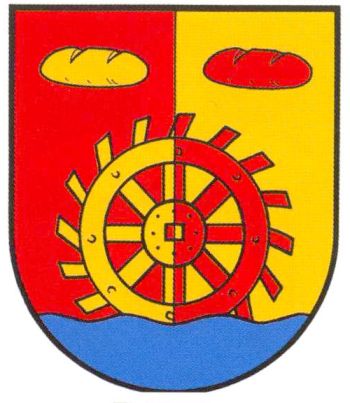Tiddische: Difference between revisions
Jump to navigation
Jump to search
Knorrepoes (talk | contribs) m (Text replacement - "/Arms of " to "/Arms (crest) of ") |
Knorrepoes (talk | contribs) m (Text replacement - "{{media}}" to " {{de1}} {{media1}}") |
||
| Line 25: | Line 25: | ||
The shield is divided to symbolise the two former villages, which were joined by the Aller river, which is shown in the base. The water-mill wheel refers to the many former water mills in the area. The two loaves of bread in the upper part refer to the fact that in the 16th century the villages had to pay taxes to the Stellfelde estate in the form of rye breads. | The shield is divided to symbolise the two former villages, which were joined by the Aller river, which is shown in the base. The water-mill wheel refers to the many former water mills in the area. The two loaves of bread in the upper part refer to the fact that in the 16th century the villages had to pay taxes to the Stellfelde estate in the form of rye breads. | ||
{{ | |||
{{de1}} | |||
{{media1}} | |||
[[Civic Heraldry Literature - Germany|'''Literature''']]: Rabbow, 2003 | [[Civic Heraldry Literature - Germany|'''Literature''']]: Rabbow, 2003 | ||
Revision as of 11:30, 26 December 2022
This page is part of the German heraldry portal Deutsche Wappensammlung |
Heraldry of the World |
|
German heraldry:
|
Selected collector's items from Germany:
|
TIDDISCHE
State : Niedersachsen
District (Kreis) : Gifhorn (until 1972 Helmstedt)
Samtgemeinde : Samtgemeinde Brome
Additions : 1972 Hoitlingen
| German | Von Rot und Gold gespalten, über blauem Wellenschildfuß, ragend ein benageltes Mühlenrad in verwechselten Farben, überholt balkenweis begleitet von zwei Brotlaibern in verwechselten Farben. |
| English | No blazon/translation known. Please click here to send your (heraldic !) blazon or translation |
Origin/meaning
The arms were officially granted on March 13, 1986.
The shield is divided to symbolise the two former villages, which were joined by the Aller river, which is shown in the base. The water-mill wheel refers to the many former water mills in the area. The two loaves of bread in the upper part refer to the fact that in the 16th century the villages had to pay taxes to the Stellfelde estate in the form of rye breads.
Literature: Rabbow, 2003


